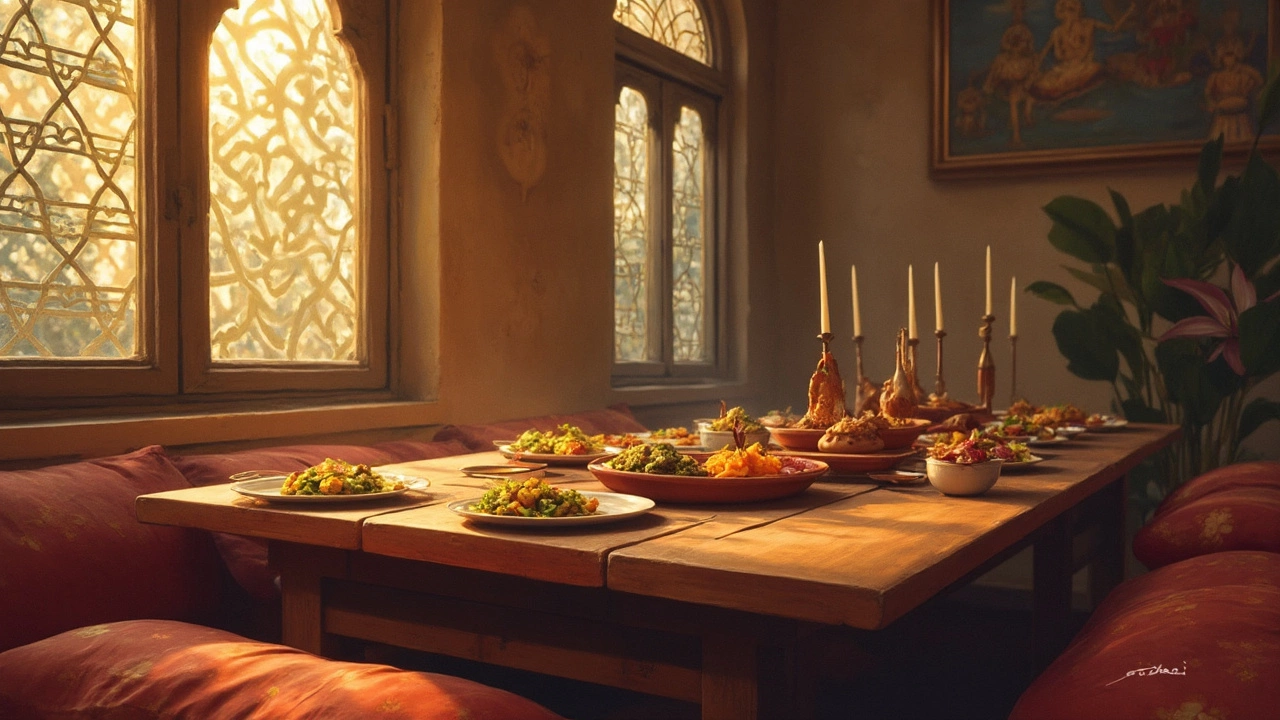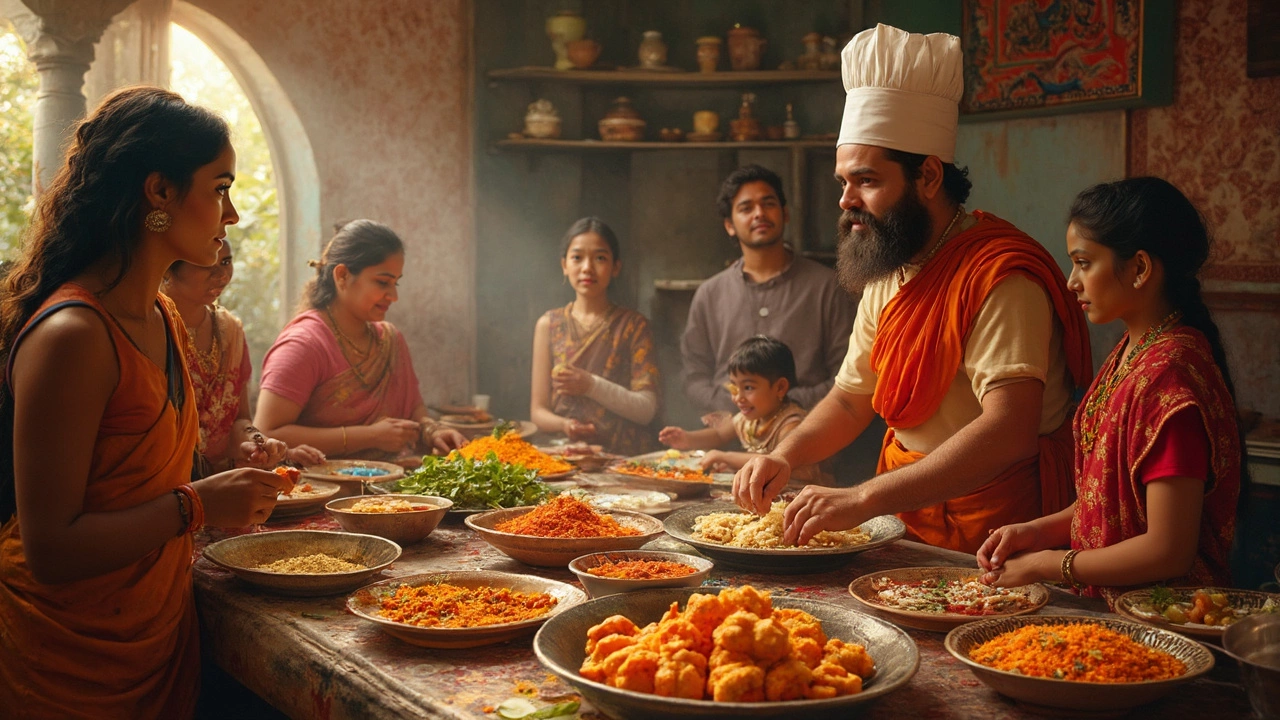Have you ever dined like a Jain? If not, you're in for an eye-opening experience. Vegetarian Jain meals are a distinct culinary art that combines ethical eating with a burst of flavors. These meals draw from the ancient Jain religion, placing a strong emphasis on non-violence and respect for all living beings. That's why, in Jain cuisine, not just meat but even certain types of vegetables are off the menu.
Yes, you read that right! Root vegetables like potatoes, onions, and garlic are no-go zones because picking them means harming the plant itself. So, what does that leave you with? Well, a treasure chest of diverse and delicious foods! Imagine savoring a meal without onions and garlic yet bursting with spices and taste. It's an art in itself, creating mouth-watering dishes using only simple, permitted ingredients.
At the heart of Jain meals is simplicity balanced with rich, varied flavors using the freshest vegetables and a play of spices. Curious about what a typical Jain meal might include? From Dal Baati Churma to Khichdi without turmeric, the options are as endless as they are innovative. And let's not forget the health benefits—thanks to the focus on fresh produce, a Jain meal is nutritious and packs in those essential vitamins and minerals.
- Jain Cooking Principles
- Ingredients to Avoid
- Flavors and Spices
- Popular Jain Dishes
- Health Benefits
- Cooking Tips
Jain Cooking Principles
Diving into the heart of a Jain meal is all about understanding their deep-rooted cooking principles. These aren't just food choices but are linked to core Jain beliefs focusing on non-violence and respect for life.
Avoiding Root Vegetables
The first thing you need to know is that root vegetables are a big no-no. This means no onions, garlic, potatoes, carrots, and so forth. Why? Uprooting these veggies harms the entire plant, conflicting with Jain values. Green, leafy vegetables and those growing above ground get the Jain green light.
No Nighttime Cooking
Ever thought about why Jains avoid cooking or eating after sunset? It's all about the risk of harming tiny organisms in low light. Daylight cooking means fewer insect casualties and shifts meal times to earlier in the day, which is quite healthy too!
Focus on Freshness
Vegetarian foods are front and center, with a strong preference for seasonal and fresh ingredients. No preserving or storing food longer than necessary. Eating freshly prepared meals ties back into the principle of minimizing harm.
The Power of Spices
What's Indian food without spices? In Jain cuisine, you can bet spices play an important role but say hello to a spice mix fashioned without onion or garlic powders. Think turmeric, cumin, coriander, and cardamom—these little wonders add flavor while keeping dishes Jain-friendly.
The 48-Minute Rule
Slightly quirky, but Jains believe that once food is cooked, it should be eaten within 48 minutes to maintain its purity and energy. Call it freshness or food karma, this rule adds a delightful twist to Jain cuisine.
Ingredients to Avoid
Embarking on the journey of preparing a vegetarian Jain meal makes you rethink common cooking ingredients. The key is staying clear of any item that might harm the plant or involve violence.
Root Vegetables
The most well-known rule is saying goodbye to root vegetables. This includes potatoes, onions, garlic, carrots, and beets. Why? Because these veggies are uprooted when harvested, potentially destroying the entire plant.
Fermented Foods
Fermentation involves microbes and creates a host environment for tiny beings. That's a no-go in Jain cooking. Thus, fermented goods like yeast and sourdough bread, beer, and even soy sauce often get the boot.
- Potatoes: Adored worldwide, but not in Jain meals.
- Onions and Garlic: Common flavor enhancers are left out.
- Carrots & Beets: Although nutritious, not Jain-friendly.
- Fermented Products: Think yogurt, beer, and yeast-based breads.
Some Spices and Greens
Even a few leafy greens and spices are avoided. Mustard greens and fennel make the list sometimes due to their intense nature.
Here's a quirky tidbit—Jains avoid honey because it's produced through the labor of bees, aligning with their non-violence principle.
| Root Vegetable | Substitute |
|---|---|
| Potato | Plantains |
| Onion | Asafoetida (hing) |
Crafting a Jain meal means getting creative with replacements and focusing on what you can use rather than what you can't. It's a test of creativity to whip up a dish using alternative ingredients and flavors.
Flavors and Spices
Let's spice things up, shall we? When it comes to vegetarian Jain meals, flavors are where the magic happens. Even without onions and garlic, these dishes are anything but bland. The secret? A well-thought-out blend of spices that make each meal almost impossibly tasty.
The Spice Staples
Jain cooking relies heavily on a selection of spices that are pantry essentials. Cumin seeds, coriander powder, and turmeric are just the beginning. Add to that a dash of asafetida, which delivers a mild onion-like flavor, and you're already halfway to heaven. And don't forget mustard seeds and fenugreek; they add that special zing leaving you wanting more.
Aromatic Herbs
Though the spice game is strong, herbs also play a starring role. Think fresh coriander leaves used as garnish or freshly grated ginger snuck into curries for an added kick. These ingredients not only enhance the taste but also add color and aroma, transforming a simple dish into a feast for the senses.
Sweet and Tangy Touch
Surprising but true: Jains love a touch of sweetness and tanginess in their food. Tamarind and jaggery find their way into numerous dishes, balancing out heat or spice. Imagine biting into a sweet yet spicy curry; it's a rollercoaster of tastes!
A Surprisingly Sweet Note
Did you know that fennel seeds, though tiny, make a big impact? Often used in Jain desserts, they add an unexpectedly sweet note. Toss them into the mix and watch the flavors take flight.
Jain meals are a masterpiece of flavors and spices, proving you don't need meat or garlic to create fabulous food. Just simple spices and herbs, used smartly, can create a meal that's both satisfying and unforgettable.

Popular Jain Dishes
Jain cuisine offers a mouth-watering array of dishes that are not only vegetarian but also deeply rooted in traditional values. With rules on ingredients, every dish is a creative masterpiece. Let's dig into some favorites, shall we?
Khichdi
Khichdi might sound basic, but in Jain cooking, it's anything but. Prepared without any root vegetables or turmeric, Jain Khichdi is a comforting mix of rice, lentils, and a special blend of spices. It's often paired with Kadhi, a yogurt-based side dish seasoned with fenugreek seeds and mustard.
Panchmel Dal
This hearty dish includes five types of dals or legumes, slow-cooked to perfection. While typically spiced with cumin and cloves, Jain Panchmel Dal skips garlic and onions, relying on fresh flavors to do the talking. It’s a protein-packed delight suitable for any day.
Sev Tameta
If you're a fan of tang, Sev Tameta is your go-to. Using tomatoes, this sweet and sour dish gains its unique texture from sev, crispy chickpea noodles. It's cooked without onions and garlic, yet still delivers a punch of flavor.
Dal Baati Churma
This is an iconic dish in Rajasthan, and it's Jain-compatible. Dal made with a mix of lentils pairs perfectly with Baati, a form of hard wheat rolls. Crumble some Baati for Churma, adding ghee and sugar. Devouring this combination is an experience like no other!
Karela Subzi
For those loving a bitter twist, try Karela Subzi. Bitter gourd gets a makeover using a range of masalas. Instead of overpowering bitterness, what you get is a tasty, delightful dish that's surprisingly addictive.
All these dishes are well-loved, highlighting that Jain meals aren't about restrictions but innovation. And hey, these are just the beginning. With a focus on fresh and accessible ingredients, Jain cuisine proves that simple is often best.
Health Benefits
So, what's the big deal about a vegetarian Jain meal when it comes to health? The benefits are pretty impressive, actually. Jain meals are all about simplicity and sustainability, and they come with a bunch of health perks.
Freshness is at the core of Jain cooking. You see, Jain meals steer clear of processed foods and prefer fresh ingredients. This focus helps in obtaining vital nutrients from natural sources. Load up on vitamins, minerals, and fiber—things your body really craves. Plus, fresh veggie-based meals are easy to digest, which can boost your gut health.
Balanced Eating
Jain meals often use a variety of grains, beans, and greens, creating a well-rounded diet. You're not just getting your regular carbs; you'll have plenty of proteins and fibers too. This balance helps maintain energy levels and keeps you feeling full longer. Great for anyone who wants to support their health while savoring delicious food!
Low in Fats
Here's another win. Jain cooking usually skips deep frying as much as possible and includes minimal oil. Low-fat foods can reduce the risk of heart disease. Jain meals, being low in saturated fats, help in maintaining an optimal cholesterol level. Good news for your heart, right?
Anti-inflammatory Benefits
Jain cuisine skips inflammatory foods like onions and garlic. Instead, it relies on spices such as turmeric and cumin. These alternatives are not just flavor enhancers; they have their own anti-inflammatory properties. Your body could benefit from reduced inflammation levels, helping with conditions like arthritis and more.
Intrigued by how much goodness is packed in every Indian Jain dish? Here's a quick snapshot:
| Benefits | Details |
|---|---|
| Good Digestion | Fresh, fiber-rich foods aid digestion |
| Heart Health | Low-fat and low-cholesterol dishes |
| Nutrition | Packed with essential vitamins and minerals |
With all these health perks, a Jain vegetarian diet isn't just good for the conscience, it's good for the body too. So the next time you're thinking about switching things up, why not try a Jain meal and see the benefits for yourself?
Cooking Tips
Cooking a vegetarian Jain meal can seem a bit daunting at first, but it's simpler than it looks if you keep a few handy tips in mind. The trick is to balance simplicity with creativity while respecting the constraints these meals come with.
Choose Your Veggies Wisely
Avoid root vegetables like garlic, onions, and potatoes. Instead, go for alternatives like spinach, tomatoes, and zucchini. These can add color and texture to your dishes without breaking any Jain dietary rules.
Flavors and Spices
Don’t shy away from spices! Cumin, coriander, turmeric, and mustard seeds can turn your dish into a masterpiece. Mix fresh ginger with lemon juice to substitute the tang and bite you lose from onions and garlic.
Cook with Care
- Start with clean, fresh ingredients. Jain cooking emphasizes purity, so washing vegetables thoroughly is key.
- Cook in small batches. This ensures everything stays fresh and is easier to manage.
- Use minimal oil for a healthier twist without compromising the taste.
Innovate with Grains and Legumes
Jain dishes are often grain-based, so play with different grains like millet, quinoa, and lentils. Not only do they provide substance, but they also pack in nutrients. Did you know quinoa is high in protein, making it great for vegetarians?
Statistical Insight: Protein Content in Grains
| Grain | Protein Content per 100g |
|---|---|
| Quinoa | 14g |
| Lentils | 9g |
| Millet | 11g |
So, there you go! A Jain meal doesn't just sit on tradition; it also evolves creatively. Experimenting with different components while adhering to Jain principles can be both fun and rewarding. Just remember, the heart of Jain meals is respect and non-violence towards every living being, so cook with that in mind!
